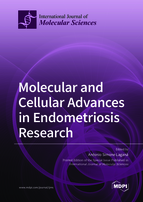Molecular and Cellular Advances in Endometriosis Research
A special issue of International Journal of Molecular Sciences (ISSN 1422-0067). This special issue belongs to the section "Molecular Endocrinology and Metabolism".
Deadline for manuscript submissions: closed (15 August 2021) | Viewed by 45605
Special Issue Editor
Interests: women’s health; minimally invasive procedures; up-to-date management; gynecology; reproductive health; surgery
Special Issues, Collections and Topics in MDPI journals
Special Issue Information
Dear Colleagues,
Endometriosis is defined as the presence of endometrial-like endometrial cells, glands, and stroma outside the uterus, causing a strong inflammatory-like microenvironment in the affected tissue. The exact prevalence of endometriosis is unknown, but estimates range from 2%–10% of women of reproductive age to 50% of infertile women. The etiopathogenesis of endometriosis remains controversial—immune, hormonal, genetic, and epigenetic factors may all be involved, and several theories have been proposed to explain it.
This Special Issue aims to publish groundbreaking research and review articles in basic and translational science (immunology, cell biology, genetics, and epigenetics) that may create new scenarios and change our perspective of the topic.
This Special Issue is a continuation of a previous one, entitled “Endometriosis Research: From Bench to Bedside” (https://0-www-mdpi-com.brum.beds.ac.uk/journal/ijms/special_issues/endometriosis_research).
Dr. Antonio Simone Laganà
Guest Editor
Manuscript Submission Information
Manuscripts should be submitted online at www.mdpi.com by registering and logging in to this website. Once you are registered, click here to go to the submission form. Manuscripts can be submitted until the deadline. All submissions that pass pre-check are peer-reviewed. Accepted papers will be published continuously in the journal (as soon as accepted) and will be listed together on the special issue website. Research articles, review articles as well as short communications are invited. For planned papers, a title and short abstract (about 100 words) can be sent to the Editorial Office for announcement on this website.
Submitted manuscripts should not have been published previously, nor be under consideration for publication elsewhere (except conference proceedings papers). All manuscripts are thoroughly refereed through a single-blind peer-review process. A guide for authors and other relevant information for submission of manuscripts is available on the Instructions for Authors page. International Journal of Molecular Sciences is an international peer-reviewed open access semimonthly journal published by MDPI.
Please visit the Instructions for Authors page before submitting a manuscript. There is an Article Processing Charge (APC) for publication in this open access journal. For details about the APC please see here. Submitted papers should be well formatted and use good English. Authors may use MDPI's English editing service prior to publication or during author revisions.
Keywords
- endometriosis
- reproductive immunology
- inflammation
- cytokines
- infertility
- in vitro fertilization
- peritoneal fluid
- apoptosis
- epigenetics
- ovary
Related Special Issues
- Molecular and Cellular Advances in Endometriosis Research 2.0 in International Journal of Molecular Sciences (12 articles)
- Endometriosis: Focusing on Molecular and Cellular Research in International Journal of Molecular Sciences (5 articles)
- Molecular and Cellular Advances in Endometriosis Research 3.0 in International Journal of Molecular Sciences (2 articles)







